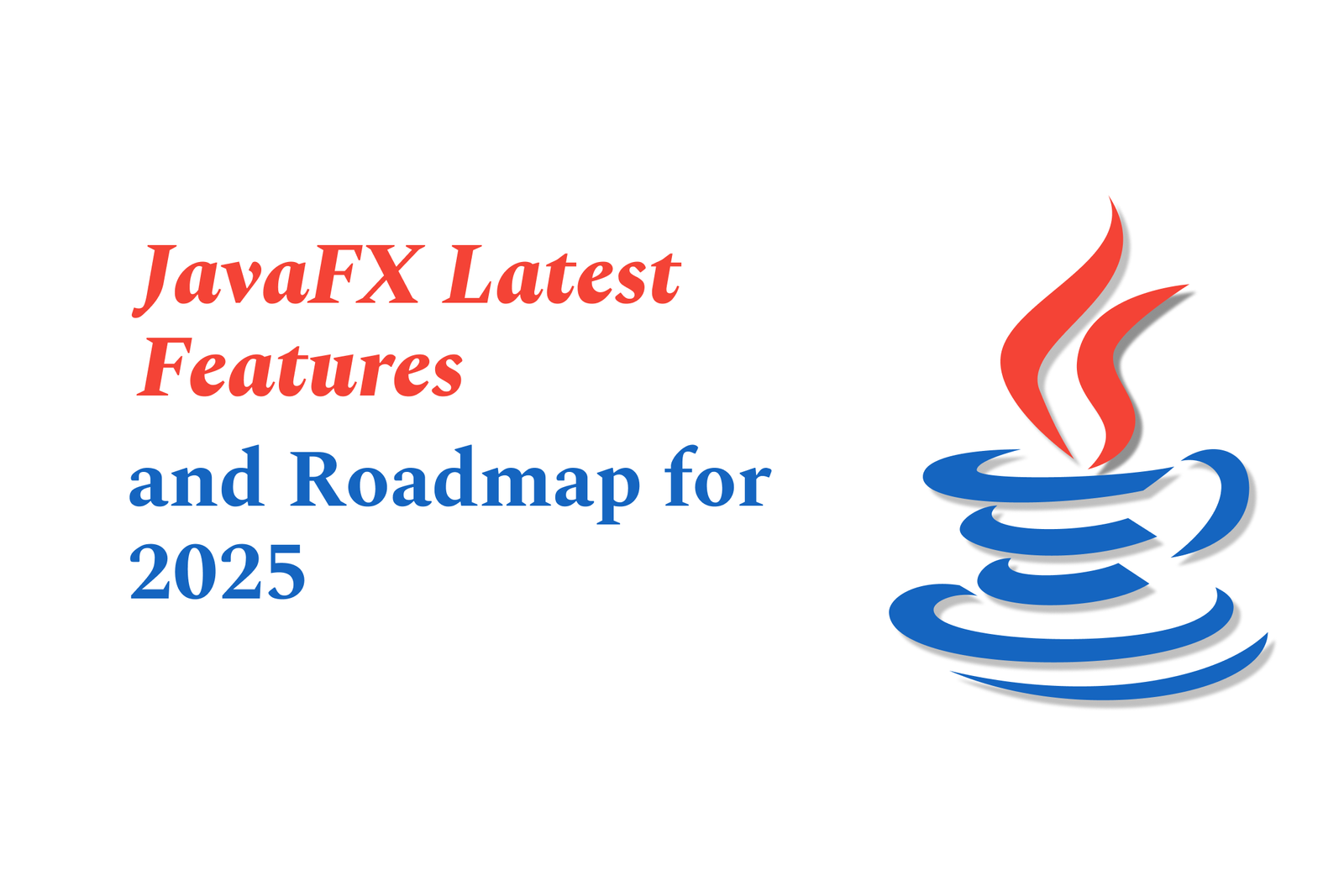JavaFX LATEST FEATURES AND ROADMAP FOR 2025
JavaFX continues to evolve with enhanced modularity, new controls like RichTextArea, improved image loading, and better native integration. The 2025 roadmap focuses on modern UI features, performance optimizations, and stronger alignment with upcoming JDK releases for robust cross-platform apps.
JavaFX Latest Features and Roadmap for 2025
1 ) Overview of JavaFX
JavaFX is an open source, modern client application platform for desktop, mobile, and embedded systems.
It enables the development of rich, cross platform graphical user interfaces using Java.
JavaFX supports a broad range of UI components, CSS styling, FXML markup, and tools like Scene Builder that bridge design and development.
2 ) Latest Features in JavaFX 24
Requires JDK 22 or higher due to updated compilation standards.
Introduces native access control to comply with JDK 24 security changes, requiring explicit enabling for JavaFX modules with native dependencies.
The jdk.jsobject module, important for WebView applications, is now included and upgraded within JavaFX, replacing the deprecated JDK version.
Pluggable image loading via Java Image I/O allows support for third party image loaders, including scalable vector graphics (SVG) with DPI awareness.
ScrollPane behavior changed to react to keyboard navigation only when focused, improving event handling within complex UI layouts.
New APIs like InputMap and enhanced focus traversal are now public, facilitating custom control development.
A new RichTextArea control is introduced in the incubator for advanced text editing.
Support for the “@1x” image naming convention is added as a fallback.
CSS enhancements include support for tree structural pseudo classes.
3 ) Important Removals and Changes
JavaFX 24 no longer supports running under the Java Security Manager, aligning with JDK 24’s disabling of this feature.
Legacy warnings related to sun.misc.Unsafe methods are present but can be suppressed and will be fixed in future JavaFX updates.
4 ) Community and Ecosystem
JavaFX is maintained by a vibrant open source community fostering continuous innovation and integration.
Rich ecosystem support includes libraries like ControlsFX, Charts, and game engines such as FXGL.
Tools like TestFX and Scene Builder enhance testing and UI design capabilities.
Themes like JMetro and MaterialFX provide modern visual styles and UI enhancements.
5 ) Roadmap and Future Outlook
JavaFX is evolving alongside the JDK with close alignment to Java release cycles, ensuring stability and access to new Java platform features.
Increasing support for modularity, enhanced native integration, and cross platform deployment remains a focus.
Continued incubation of new controls and APIs promises more powerful and customizable GUI options.
The roadmap emphasizes improving developer experience, performance optimizations, and expanding support for emerging UI paradigms.
6 ) Getting Started and Support
JavaFX is available as standalone SDKs and Maven artifacts compatible with various JDK versions.
Comprehensive documentation, tutorials, API references, and community forums provide excellent onboarding support.
Leading organizations like Oracle and contributors from the Java community actively support its growth.
Commercial support options and tailored Linux runtimes are provided by companies such as BellSoft for enterprise needs.
Summary
JavaFX continues to be a powerful, flexible, and evolving Java based UI toolkit with significant enhancements in version 24. Its roadmap into 2025 focuses on modernization, modularity, and richer UI capabilities to support developers building sophisticated, cross platform applications. The platform’s strong community engagement and ecosystem growth position it as a future ready solution for Java client development.
https://justacademy.in/news-detail/android-performance-benchmarking-updates
https://justacademy.in/news-detail/java-in-e-commerce-platforms:-innovations
https://justacademy.in/news-detail/android-app-store-alternatives-news
https://justacademy.in/news-detail/java?s-role-in-big-data-analytics-today
https://justacademy.in/news-detail/react-native-community-surges-with-new-plugins-and-tools
Related Posts
In 2025, top Angular libraries offer modern, feature-rich components and tools for building dynamic web apps. From powerful data grids to low-code platforms like UI Bakery, these libraries enhance development speed, UI design, and scalability, making them essential for Angular developers.
Migrating from AngularJS to Angular 17 involves gradually upgrading your app by running both frameworks together using tools like ngUpgrade, rewriting components in TypeScript, and adopting Angular’s modern architecture to enhance performance, maintainability, and long-term support.
Angular state management tools help organize and handle app data efficiently, improving scalability and maintainability. Popular options include NgRx for robust, RxJS-based patterns, and newer Signal Store solutions that offer simpler, reactive approaches integrated tightly with Angular’s latest features.
RxJS in Angular empowers developers to manage asynchronous data streams with powerful operators like `forkJoin`, `combineLatest`, and `zip`. Mastering these key operators in 2025 is essential for building efficient, reactive applications that handle complex event sequences seamlessly.
Angular performance optimization in 2025 focuses on improving app speed and responsiveness by using techniques like OnPush change detection, lazy loading, efficient data caching, and AOT compilation. These practices reduce load times, enhance user experience, and ensure scalable, fast Angular applications.
In 2025, Angular remains preferred for large-scale, enterprise apps with its robust, all-in-one framework, while Vue attracts developers seeking simplicity and fast development for smaller projects. Both frameworks excel, with choice driven by project needs and team expertise.
Angular Signals are a new reactive primitive in Angular 16 that enable fine-grained, efficient change detection by automatically tracking dependencies and updating only affected parts of the UI. They simplify state management and boost app performance, revolutionizing Angular's reactivity model.
Angular interview questions to prepare in 2025 focus on core concepts like components, directives, data binding, routing, and dependency injection, along with TypeScript mastery and latest Angular features to ensure strong practical knowledge for building scalable, efficient web applications.
AngularJS reached its official end of support in January 2022, meaning no further updates or security patches. To ensure app security and performance, developers should consider migrating to modern Angular versions or seek third-party long-term support options if immediate migration isn’t possible.
The Angular Roadmap 2025 highlights upcoming features focused on improving developer experience and performance, including zoneless Angular, Signals integration, enhanced Forms, async data handling, improved HMR, and expanded Angular Material/CDK enhancements, driving modern, efficient web app development.










